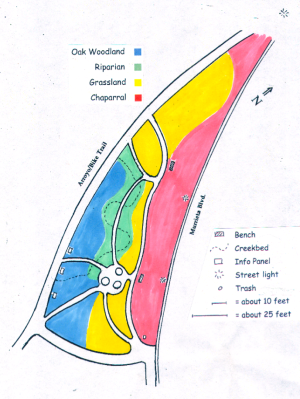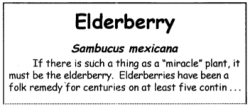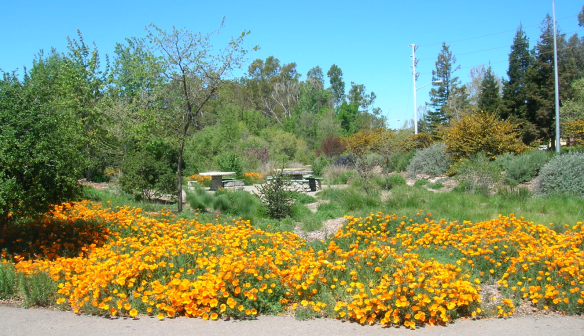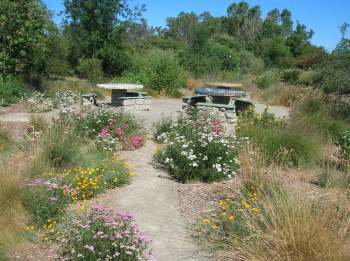Welcome to the Granada Native Garden! In 2004, the Friends of the Arroyos and Granada High School students built a native plant park called the Granada Native Garden. This park is divided into various plant communities: chaparral, oak woodland, grassland meadow, and riparian habitats. Picnic tables, benches and three outdoor educational panels were also installed. We hope that this Garden will be not only an outdoor classroom, but also an opportunity for all Livermore residents to recognize the environmental importance of native plants, and to reduce their household water use by incorporating native plants into their landscaping. The illustration below shows the location of each of the four plant communities or habitats. On the right of the illustration is Murrieta Blvd.; the Arroyo Mocho bike ‘n hike trail is on the left. The top of the illustration is the north end of the Garden, toward Stanley Ave.
How to Get to the Granada Native Garden On foot, you can take  either Murrieta Blvd. or the Arroyo Mocho trail. Unfortunately, there is no park- ing available at the Garden itself, but parking is available in the Nob Hill shopping center across the street. If you park there, you are advised to walk a short distance to the pedestri- an crossing east of the shopping center, cross Murrieta Blvd., then walk back to the Garden.
either Murrieta Blvd. or the Arroyo Mocho trail. Unfortunately, there is no park- ing available at the Garden itself, but parking is available in the Nob Hill shopping center across the street. If you park there, you are advised to walk a short distance to the pedestri- an crossing east of the shopping center, cross Murrieta Blvd., then walk back to the Garden.
What You Will See at the Granada Native Garden The Garden is populated strictly with California native plants, but not all are necessarily native to this part of California. Likewise, not all of the plants are in bloom at the same time of the year, and some have blossoms that are not conspicuous. But all of them have some characteristics that make them interesting in one way or another, and all of them subsist on no artificial irrigation or, in some cases, a little summer water applied by hand. Three picnic tables form a focal point for the Garden, as well as a place to sit and take in the environment, or to share a conversation with friends or a picnic lunch with your family. The tables are decorated with mosaics depicting endangered species: fish, frogs and birds. This area contains some of the more colorful plants in the Garden. Beyond the table area, paths lead to the other end of the Garden which is less formally planned, and, to a certain extent, is still being developed with new plantings as time goes on.
 Identification Markers When a particular plant is showing off its flowers, fruit or foliage, we try to place an identi-fication marker near the plant to tell you what its name is. Often the plant also has some inter-esting facts about its importance to the environ- ment, its use by Native Americans, its folklore, or other details. The ID marker is a plastic tube with a brown cap, slipped over a stake set in the ground. These markers are often mistaken for irrigation outlets (of which there are none in the Garden). But the tube may easily be lifted off the stake so that you can read it conveniently and learn about the plant.
Identification Markers When a particular plant is showing off its flowers, fruit or foliage, we try to place an identi-fication marker near the plant to tell you what its name is. Often the plant also has some inter-esting facts about its importance to the environ- ment, its use by Native Americans, its folklore, or other details. The ID marker is a plastic tube with a brown cap, slipped over a stake set in the ground. These markers are often mistaken for irrigation outlets (of which there are none in the Garden). But the tube may easily be lifted off the stake so that you can read it conveniently and learn about the plant.  Because of past vandalism problems, we don’t leave the ID markers in place per- manently, or they tend to “disappear”. We only ask that when you pick one up to read it (and we hope you do! ), you are careful to put it back on its stake.
Because of past vandalism problems, we don’t leave the ID markers in place per- manently, or they tend to “disappear”. We only ask that when you pick one up to read it (and we hope you do! ), you are careful to put it back on its stake.

 You Can Help!
You Can Help!
Louann, Jim, Mary Ann, Kerry, Dave and Kirpa help to maintain the Granada Native Garden. You can help too, by letting us know how to improve the Garden, by responding to this newsletter, or by stopping by to chat when we are working. Or if you happen to notice any vandalism, graffiti or unappropriate activity taking place, please call the Livermore Police at 925-371-4987.


